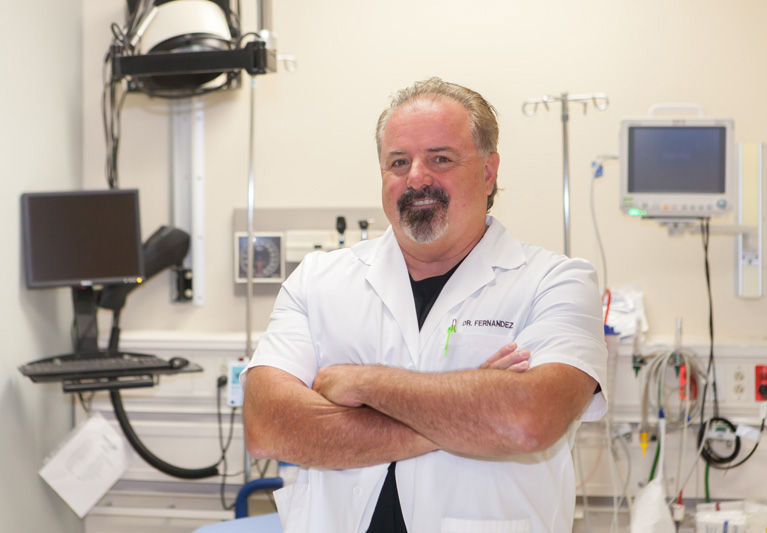
Every year more than 7,000 Americans die from heat stroke, claiming more lives in the U.S. than hurricanes, tornadoes, lightning strikes and all other weather-related causes combined.
Now there’s new evidence that things might be about to get worse.
A team of scientists at Stanford University last week published a report in the journal “Nature” arguing the eastern half of North America, Europe and parts of western Asia will be prone to even more intensive heat waves than usual in the coming decade.
That’s not good news for Dr. John Fernandez at the Sebastian River Medical Center’s emergency room.
Each summer Fernandez sees and treats a wide variety of heat-related conditions including heat syncope, heat cramps, heat edema and the biggest heat-related killer of them all, heat stroke.
Those over 50 are, hands down, the most vulnerable to heat stroke. They account for a staggering 80 percent of all heat-related deaths in this country each year.
Making matters worse, according to Fernandez, “Just about any kind of medication or pre-existing condition can complicate heat stress.” He cites diabetes, renal or kidney problems and hypertension along with the commonly prescribed drugs used to treat those problems as risk factors to consider.
The University of Maryland’s medical center adds that, “Taking medications that interfere with the body’s ability to cool itself, including antipsychotics, tranquilizers, antihistamines, tricyclic antidepressants, beta-blockers and some over-the-counter sleeping pills,” are often overlooked elements in the occurance and treatment of heat stroke.
Heat stress or “hyperthermia” is often progressive. There can be up to four stages leading to heat stroke. Or heat stroke can strike in just a matter of minutes with no warning signs.
According to the National Institutes of Health, “Heat syncope,” might come first and is typified by sudden dizziness. Those taking heart medications like beta blockers are particularly susceptible to this. Drinking water and resting in a cool place usually makes this form of heat stress go away.
“Heat cramps” can follow if precautions aren’t taken. These cramps are the painful tightening of muscles in the stomach, arms or legs and are another sign the body’s temperature is too high. Again, drinking water and moving to a cooler place should eliminate the problem.
Fernandez cautions that “water, water, water” is the best choice for re-hydration as both coffee and tea contain caffeine which can actually dehydrate the body.
“Heat edema” is next on the list and is characterized by swelling in the ankles and feet. If moving to a cooler place and putting the feet up doesn’t reduce that swelling fairly quickly, it’s time to check with your doctor.
Now comes the real danger zone.
“Heat exhaustion,” says NIH, “Is a warning that your body can no longer keep itself cool. You might feel thirsty, dizzy, weak, uncoordinated, and nauseated. You may sweat a lot. Even though your body temperature stays normal, your skin feels cold and clammy. Some people with heat exhaustion have a rapid pulse. Rest in a cool place and get plenty of fluids. If you don’t feel better soon, get medical care. Be careful – heat exhaustion can progress to heat stroke.”
“Heat stroke” is the killer. Call 911. Get medical help right away. Older people living in homes or apartments without air conditioning or fans and those with chronic diseases are most at risk.
The Mayo Clinic explains heatstroke as, “A condition caused by your body overheating, usually as a result of prolonged exposure to or physical exertion in high temperatures. This most serious form of heat injury, heat stroke can occur if your body temperature rises to 104 or higher. Untreated heat stroke can quickly damage your brain, heart, kidneys and muscles. The damage worsens the longer treatment is delayed, increasing your risk of serious complications or death.”
Fernandez points out that people over the age of 50, “have less myocardial and cardiovascular reserve” and that can be a recipe for tragedy.
Why? Because the Mayo Clinic says that while heat stroke, “often occurs as a progression from milder heat-related illnesses such as heat cramps, heat syncope and heat exhaustion, it can also strike even if there have been no previous signs of heat injury.” Heat stroke can come on in as little as 15 minutes.
Fernandez suggests “Holding ice in your hands. Your hands are highly vascular,” he continues, so they can help spread the cooling effect to the rest of the body quickly. “Hold a chunk of ice in your hand until it’s gone and then hold another,” is his recommendation while waiting for help to arrive. Cold baths or showers may also help reduce body temperature.
Limiting activities in the summer sun, says Fernandez, is one of the best ways to steer clear of heat stroke. Even gardening is best done in the early morning or early evening hours when it’s cooler outside, according to this ER doctor.
Heat stroke can and does kill. It can also cause irreparable damage to the brain and other internal organs. Those who have experienced symptoms should get medical care immediately.
According to the Mayo Clinic, medical treatments may include total immersion in cold water or the use of evaporation techniques using a cold water mist sprayed onto the skin while warm air is blown over the body with fans. Other doctors may opt to wrap the patient in ice and cooling blankets while also administering muscle relaxants such as benzodiazepine.
Sadly, heat stroke doesn’t get much attention in the media.
Sure, every summer, the talking heads of television will report for a day or two on the tragic loss of young high school and college football players or an infant carelessly locked inside a hot car, but when 80 percent of all heat related deaths are people over the age of 50, awareness of the symptoms and the need for immediate treatment might go a long way towards reducing the annual death toll from this summertime killer.



